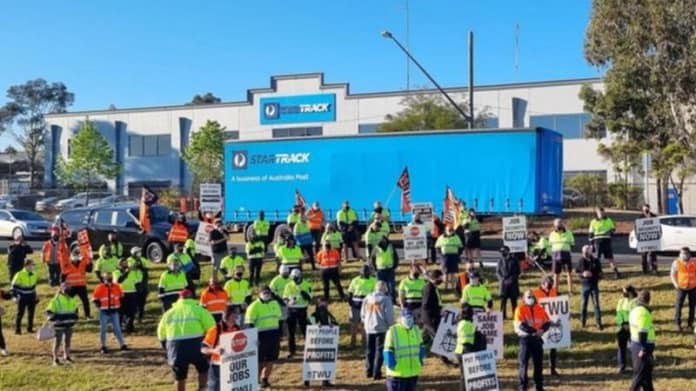WITH MORE THAN 75 per cent of the population fully vaccinated, NSW has begun easing COVID restrictions, with Victoria to follow in late October.
The end of the discriminatory lockdown of Western Sydney is more than welcome. Public health orders became an excuse for racist policing. In July and August more than 28,000 COVID fines were issued—about 13 times the number issued during the whole of 2020.
In Victoria, unnecessary curfews are still in place, and police prevented a protest picnic in support of refugees, although Dan Andrews is allowing 10,000 fully vaccinated people to attend the Melbourne Cup.
NSW will reach 90 per cent double vaccination by November. But Scott Morrison’s failures mean groups that were supposed to have the highest priority including Indigenous people and people with disabilities remain at risk.
Vaccination in Indigenous communities remains a scandal. In mid-October only 58 per cent of Indigenous people aged over 16 in NSW were double vaccinated, compared to the state average of 75 per cent. Nationwide just 40 per cent of Indigenous people are fully vaccinated.
In disability group homes, supposedly the same priority as aged care centres, only 68.7 per cent are fully vaccinated.
The sack
Instead of expanding access and providing the education and persuasion needed, state governments are increasingly relying on authoritarian vaccine mandates.
But threatening workers with the sack if they aren’t vaccinated risks hardening people in their opposition—and driving them into the arms of anti-vaxxers and the far right.
Too much of the left and the union movement has fallen for the idea that anyone who is vaccinate hesitant is a fascist or a scab. This can only divide workers and weaken the unions.
Governments, state and federal, are blaming unvaccinated people to cover up their failures to roll-out vaccines or take measures to make workplaces safe. Although the NSW government has had months to prepare schools for re-opening, it has belatedly ordered just 10,000 air purifiers, although there are more than 2200 government schools, with many more than five classrooms each. Victoria has ordered 51,000.
It’s also clear that hospital funding must be massively boosted. In Queensland, even without any COVID outbreak, hospitals are already operating at 100 per cent capacity.
Morrison has rejected state governments’ demands for more funds as a “political shakedown”.
Poverty
Even though real rates of unemployment are rising, and the economy is stalling, Morrison is ripping away financial assistance for those thrown out of work through lockdowns.
After states hit 80 per cent vaccination, payments will drop back to the rate of JobSeeker in the second week, pushing more people into poverty. In NSW this will happen within three weeks of lockdown ending. There will be no support after 80 per cent if any state imposes new restrictions.
Yet Morrison is spending tens of billions on nuclear submarines and other military hardware. Another $1.3 billion for new US-made Seahawk helicopters has just been announced.
That money should be used to fund hospitals, safety measures and an increase to JobSeeker. But Labor has adopted a small-target approach to the coming federal election, saying it supports the nuclear submarines and the Liberals’ tax cuts for the rich.
Opinion polls are showing Labor ahead of the Liberals 53-47, but real struggle will be needed to get rid of Morrison and win real change.
Fightback needed
Most unions responded to COVID by declaring we were “all in it together”, putting any fight against the government on hold and suspending strikes.
But inequality and class divisions have fuelled the crisis—from the casual workers unable to take sick leave to the essential workers in Melbourne and Sydney’s working class areas catching the virus at work.
In Melbourne, data for the most recent outbreak shows the most disadvantaged areas have experienced 10 times more cases that the most affluent.
Reopening must not mean a return to business as usual.
As restrictions lift workers need to go on the offensive. Unions at Sydney and NSW trains staged a four-hour strike on 28 September and are preparing for further action. Teachers and nurses in NSW are preparing for strikes. Victorian teachers have also voted for industrial action.
Patrick’s workers across the country have taken strike action. Truck drivers at StarTrack, FedEx and Linfox are threatening co-ordinated strikes to fight casualisation and outsourcing. Cadbury workers in Melbourne have also gone to strike to demand permanent jobs.
Serious strike action is the way to fight for secure jobs, decent pay rises, and improved safety and conditions.
With Morrison refusing to adopt serious targets and pouring money into his “gas-fired recovery”, the rallies on 6 November around the COP26 climate summit need to be the start of concerted action by the climate movement.
The COVID crisis has starkly revealed the conflict between profit and human life. The climate crisis is also driven by capitalism’s contempt for people and planet. We need to build the struggles for workers’ rights and climate action and fight for a better world.






